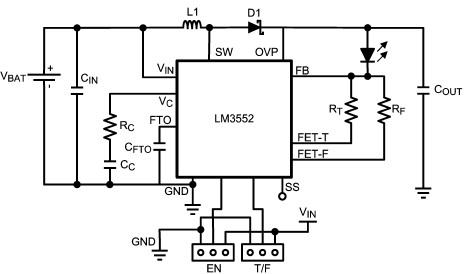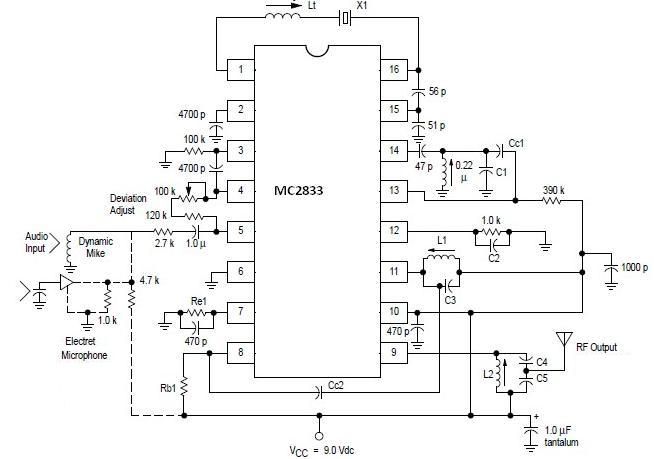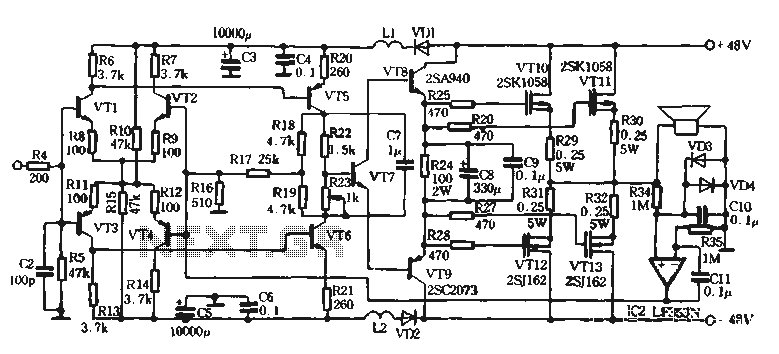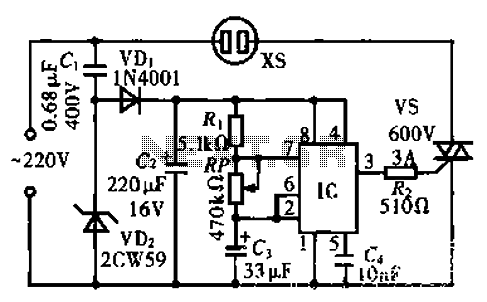
STA550 - 2 x 70W Audio Amplifier Circuit
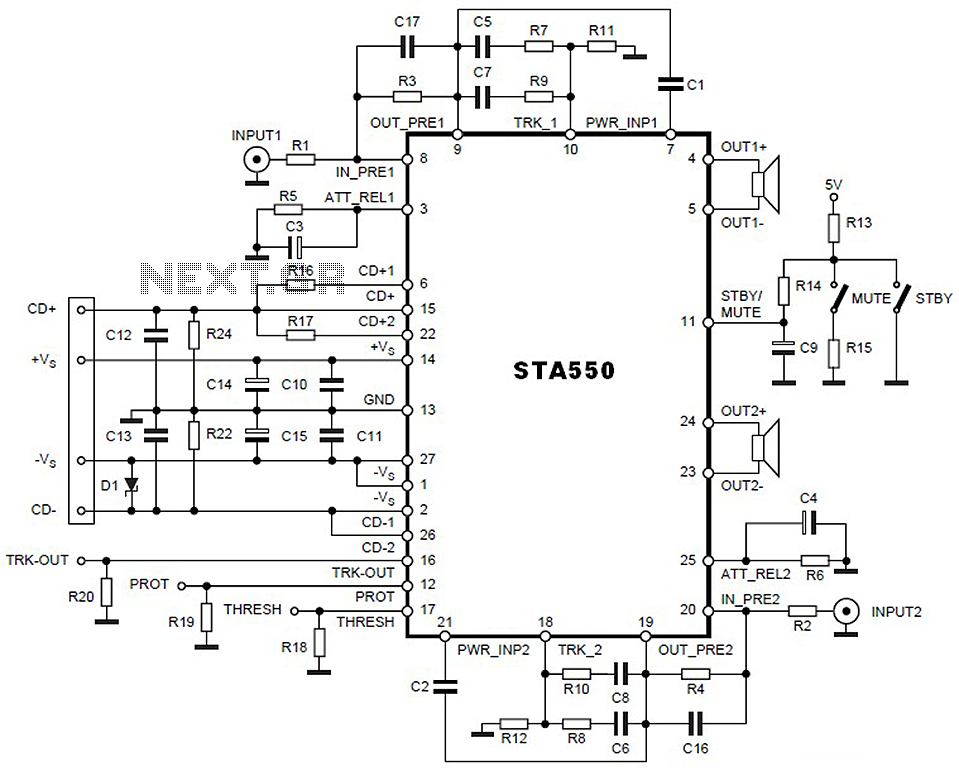
This is a 2 x 70W audio power amplifier circuit built using a single IC STA550. The amplifier circuit requires a few external components, primarily resistors and capacitors, and is straightforward to design. The STA550 audio amplifier can provide a maximum output power of 70 watts on two channels (70 + 70 watts). This power amplifier circuit requires a multi-voltage power supply, consisting of: +Vs positive supply voltage referenced to pin 13 (GND), -Vs negative supply voltage also referenced to pin 13 (GND), VCD+ positive supply voltage tracking rail, and VCD- negative supply voltage tracking rail. The +Vs positive supply voltage can range from +20 to +30 volts, while the -Vs negative supply voltage can range from -10 to -22 volts. The positive supply voltage tracking rail VCD+ can vary from +3 to 17 volts, and the negative supply voltage tracking rail VCD- can range from -17 to -3 volts. It is essential that VCD- does not exceed -Vs and VCD+ does not exceed +Vs. In this circuit diagram, the ratio of R1/R3 (or R2/R4) determines the gain of the preamplifier. If the input signal is very low, it is possible to increase the gain by adjusting the product Vin*G = constant. In this scenario, the gain G can be increased by decreasing R1 and R2 from 10kΩ to 2kΩ without significant effects on circuit behavior, while remaining within the operating range Iin_max = Vin_max/R1(2) < 1mA.
The 2 x 70W audio power amplifier circuit utilizing the STA550 IC is designed to deliver robust audio performance with a dual-channel output. The circuit's simplicity is attributed to its reliance on a minimal number of external components, which primarily include resistors and capacitors that shape the amplifier's frequency response and gain characteristics. The STA550 is engineered for high efficiency, allowing it to achieve substantial output power while managing thermal performance effectively.
The power supply requirements are critical for the correct operation of the amplifier. The dual voltage supply ensures that the amplifier can handle a wide dynamic range and provides the necessary headroom for audio signals. The specified voltage ranges for +Vs and -Vs are designed to optimize performance while preventing distortion or clipping during operation. The tracking rails, VCD+ and VCD-, are essential for maintaining the stability of the amplifier under varying load conditions.
The gain configuration, determined by the resistor ratios R1/R3 and R2/R4, allows for versatility in audio applications. This feature is particularly beneficial in scenarios where the input signal level may be insufficient. By adjusting the resistor values, the designer can tailor the gain to suit specific input conditions without compromising the integrity of the audio signal. The operating current limit, defined by Iin_max, ensures that the amplifier remains within safe operating conditions, thereby enhancing reliability and longevity.
This amplifier circuit is suitable for a variety of applications, including home audio systems, public address systems, and musical instrument amplification, where high fidelity and power output are essential. The design principles employed in the STA550 amplifier circuit exemplify modern approaches to audio amplification, combining efficiency, simplicity, and flexibility.This is a 2 x 70W audio power amplifier circuit which built using single IC STA550. The amplifier circuit require few external components (most of them are resistors and capacitors) and is very easy to design The STA550 audio amplifier is capable to provide a maximum output power of 70 watts on two channels (70 + 70 watts). This power amplifier ci rcuit require a multi voltage power supply, because the amplifier require : +Vs Positive supply voltage referred to pin 13 (GND), Negative supply voltage referred to pin 13 (GND) -Vs, VCD+ Positive supply voltage tracking rail, VCD- Negative supply voltage tracking rail. The +Vs Positive supply voltage can be : +20 to +30 volts, -Vs Negative supply voltage : -10 to -22 volts, Positive supply voltage tracking rail VCD+ : +3 to 17 volts, Negative supply voltage tracking rail VCD- : -17 to -3 volts.
VCD- must not be more negative than -Vs and VCD+ must not be more positive than +VS. In this circuit diagram, R1/R3 (or R2/R4) ratio fix the gain of the preamplifier. If the input signal is very low, is possible to increase the gain fixing the product Vin*G = cost. In that case is possible to increase G decreasing R1, 2 from 10KW until 2KW without relevant effetcs on the circuit behavior and remaining in the operating range Iin_max = Vin_max/R1(2) <1ma. >This is a 2 x 70W audio power amplifier circuit which built using single IC STA550. 🔗 External reference
The 2 x 70W audio power amplifier circuit utilizing the STA550 IC is designed to deliver robust audio performance with a dual-channel output. The circuit's simplicity is attributed to its reliance on a minimal number of external components, which primarily include resistors and capacitors that shape the amplifier's frequency response and gain characteristics. The STA550 is engineered for high efficiency, allowing it to achieve substantial output power while managing thermal performance effectively.
The power supply requirements are critical for the correct operation of the amplifier. The dual voltage supply ensures that the amplifier can handle a wide dynamic range and provides the necessary headroom for audio signals. The specified voltage ranges for +Vs and -Vs are designed to optimize performance while preventing distortion or clipping during operation. The tracking rails, VCD+ and VCD-, are essential for maintaining the stability of the amplifier under varying load conditions.
The gain configuration, determined by the resistor ratios R1/R3 and R2/R4, allows for versatility in audio applications. This feature is particularly beneficial in scenarios where the input signal level may be insufficient. By adjusting the resistor values, the designer can tailor the gain to suit specific input conditions without compromising the integrity of the audio signal. The operating current limit, defined by Iin_max, ensures that the amplifier remains within safe operating conditions, thereby enhancing reliability and longevity.
This amplifier circuit is suitable for a variety of applications, including home audio systems, public address systems, and musical instrument amplification, where high fidelity and power output are essential. The design principles employed in the STA550 amplifier circuit exemplify modern approaches to audio amplification, combining efficiency, simplicity, and flexibility.This is a 2 x 70W audio power amplifier circuit which built using single IC STA550. The amplifier circuit require few external components (most of them are resistors and capacitors) and is very easy to design The STA550 audio amplifier is capable to provide a maximum output power of 70 watts on two channels (70 + 70 watts). This power amplifier ci rcuit require a multi voltage power supply, because the amplifier require : +Vs Positive supply voltage referred to pin 13 (GND), Negative supply voltage referred to pin 13 (GND) -Vs, VCD+ Positive supply voltage tracking rail, VCD- Negative supply voltage tracking rail. The +Vs Positive supply voltage can be : +20 to +30 volts, -Vs Negative supply voltage : -10 to -22 volts, Positive supply voltage tracking rail VCD+ : +3 to 17 volts, Negative supply voltage tracking rail VCD- : -17 to -3 volts.
VCD- must not be more negative than -Vs and VCD+ must not be more positive than +VS. In this circuit diagram, R1/R3 (or R2/R4) ratio fix the gain of the preamplifier. If the input signal is very low, is possible to increase the gain fixing the product Vin*G = cost. In that case is possible to increase G decreasing R1, 2 from 10KW until 2KW without relevant effetcs on the circuit behavior and remaining in the operating range Iin_max = Vin_max/R1(2) <1ma. >This is a 2 x 70W audio power amplifier circuit which built using single IC STA550. 🔗 External reference
